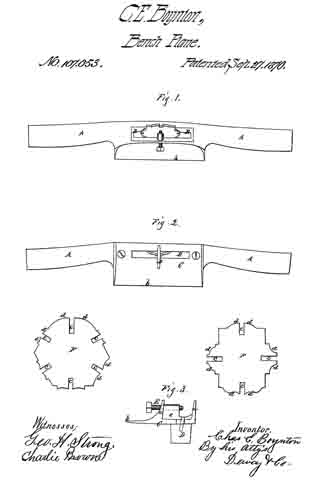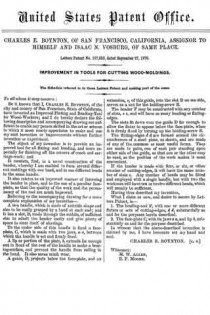
| PLEASE NOTE: The images presented on this page are of low resolution and, as a result, will not print out very well. If you wish to have higher resolution files then you may purchase them for only $2.95 per patent by using the "Buy Now" button below. All purchases are via PayPal. These files have all been cleaned up and digitally enhanced and are therefore suitable for printing, publication or framing. Each zip package contains all the images below (some packages may contain more), and purchased files can be downloaded immediately. |
United States Patent Office.
CHARLES E. BOYNTON, OF SAN FRANCISCO, CALIFORNIA, ASSIGNOR TO
HIMSELF AND ISAAC N. VOSBURG, OF SAME PLACE.
Letters Patent No. 107,653, dated September 27, 1870.
_________________
IMPROVEMENT IN TOOLS FOR CUTTING WOOD-MOLDINGS.
_________________
The Schedule referred to in these Letters Patent and making part of the same.
_________________
To all whom it may concern:
Be it known that I, CHARLES E. BOYNTON, of the city and county of San Francisco, State of California, have invented an Improved Fluting and Beading-Tool for Wood-Workers; and I do hereby declare the following description and accompanying drawing are sufflcient to enable any person skilled in the art or science to which it most nearly appertains to make and use my said invention or improvements without further invention or experiment.
The object of my invention is to provide an improved tool for all fluting and beading, and more especially for finishing off the corners of coach and carriage-work; and
It consists, first, in a novel construction of the beader, whereby I am enabled to form several different moldings with one bead, and to use different beads in the same handle.
It also relates to an improved manner of fastening the bender in place, and to the use of a peculiar face-plate, so that the quality of the work and the permanency of the tool are much improved.
Referring to the accompanying drawing for a more complete explanation of my invention —
A is a handle, which is made of suitable shape and size to be easily grasped by a hand at each end; and it has a slot, B, made through the middle, of sufficient size to admit the header easily and give plenty of space to clear itself of shavings.
To the under side of this handle is fixed a face-plate, C, which is made with two jaws, a a, between which the handle is set and firmly fixed.
A lip or portion of the plate, D, extends far enough out in front of the rest of the handle to make a bearing-surface, and prevent the handle from rolling in the hand. It also saves much wear.
A guide, D, projects below the face-plate, and an extension, e, of this guide, into the slot B on one side, serves as a nut for the holding-screw E.
The beader F may he constructed with any number of slots, c c, and will have as many beading or fluting-edges.
The slots fit down over the guide D far enough to allow the fluter to appear below the face-plate, when it is firmly fixed by turning up the holding-screw E.
The fluting-edges d d are formed around the circumference of a steel plate, as shown, and are made of any of the common or most useful forms. They are made in pairs, one of each pair standing upon either side of the guide, so that one or the other may be used, as the position of the work makes it most convenient.
If the beader is made with four, or six, or other number of cutting-edges, it will have the same number of slots c. Any number of beads may be fitted and employed with a single handle, but with two the workman will have ten or twelve different beads, which will usually be sufficient.
Having thus described my invention, What I claim as new, and desire to secure by Letters Patent, is —
1. The beading-tool F, with one or more different fluters or sets of cutting-edges, d d, substantially as and for the purposes herein described.
2. The face-plate C, with its jaws a a, and lip b, substantially as and for the purpose described.
In witness that the above-deseribed invention is claimed by me, I have hereunto set my hand and seal.
CHARLES E. BOYNTON. [L. S.]
Witnesses:
M. W. ALLEN,
E. F. MOORE.


